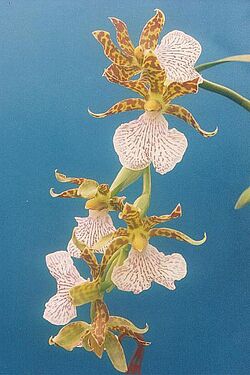Biology:Zygopetalinae
| Zygopetalinae | |
|---|---|

| |
| Zygopetalum maculatum | |
| Scientific classification | |
| Kingdom: | Plantae |
| Clade: | Tracheophytes |
| Clade: | Angiosperms |
| Clade: | Monocots |
| Order: | Asparagales |
| Family: | Orchidaceae |
| Subfamily: | Epidendroideae |
| Tribe: | Cymbidieae |
| Subtribe: | Zygopetalinae Schltr. |
| Genera | |
|
See text | |
Zygopetalinae is an orchid subtribe in the tribe Cymbidieae with 418 species.[1]
Description
Orchids in Zygopetalinae are mostly epiphytic but can be terrestrial, with pseudobulbs of one or several internodes or slender stems. All genera but one are sympodial.[2] Leaves are convolute or duplicate, plicate, and articulate, with a smooth cuticle. Inflorescences of one to several spiral flowers rise from young shoots laterally. Flowers vary in size and can be resupinate. Columns can be winged or flattened and usually have a distinct foot. The anther can be either terminal or ventral, with an operculum. Velamen resembles that of the genus Cymbidium.[3]
Plants have 46, 48, or 52 chromosomes.[3]
Genera
Genera include:
Distribution and habitat
Species of the subtribe occur throughout the American tropics, from southern Mexico in North America to northern Argentina and Bolivia in South America. The northernmost species are of the genera Kefersteinia and Stenotyla in North America, and the southernmost in South America are in the genera Warrea and Zygopetalum.[4] The greatest diversity in genera and species occurs along the Andes mountains.[5]
Plants of Zygopetalinae grow from sea level to 2,500 m (8,200 ft) in altitude. Most plants are adapted to shaded and wet conditions of the lower canopy, in soil or on often moss covered host trees.[4]
Ecology
Members of Zygopetalinae are pollinated by Euglossine bees, most often by perfume-gathering males. Some species of Cochleanthes are an exception, attracting nectar-seeking bees. Most genera place their pollinaria on the bee's head, thorax, or scutellum, though Chaubardiella places its pollinaria on the bee's trochanters and Kefersteinia places its pollinaria on the bee's antennae bases.[3]
See also
References
- ↑ Whitten, W.; Williams, Norris; Dressle, Robert; Gerlach, Gunter; Pupulin, Franco (2005). "Generic relationships of Zygopetalinae (Orchidaceae: Cymbidieae): combined molecular evidence". Lankesteriana International Journal on Orchidology (Universidad de Costa Rica) 5 (2). ISSN 1409-3871. http://www.redalyc.org/html/443/44339808001/.
- ↑ Dahlgren, Rolf M. T.; Clifford, H. Trevor; Yeo, Peter F. (1985). The Families of the Monocotyledons : Structure, Evolution, and Taxonomy. Berlin, Heidelberg: Springer Berlin Heidelberg. pp. 273. ISBN 978-3-642-61663-1. OCLC 851703009.
- ↑ 3.0 3.1 3.2 Robert L. Dressler (1993). Phylogeny and Classification of the Orchid Family (illustrated ed.). Cambridge University Press. p. 172. ISBN 9780521450584.
- ↑ 4.0 4.1 Alec M. Pridgeon, ed (2009). Genera Orchidacearum. Genera Orchidacearum. 5 (illustrated ed.). Oxford University Press, USA. pp. 456–458. ISBN 9780198507130.
- ↑ William Louis Stern (2014). Orchidaceae. Anatomy of the Monocotyledons. 10 (illustrated ed.). Oxford University Press. p. 199. ISBN 9780199689071.
Wikidata ☰ Q2529755 entry
 |

